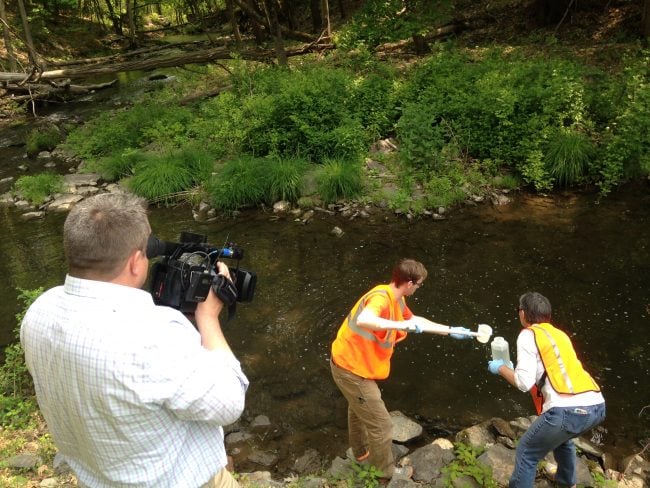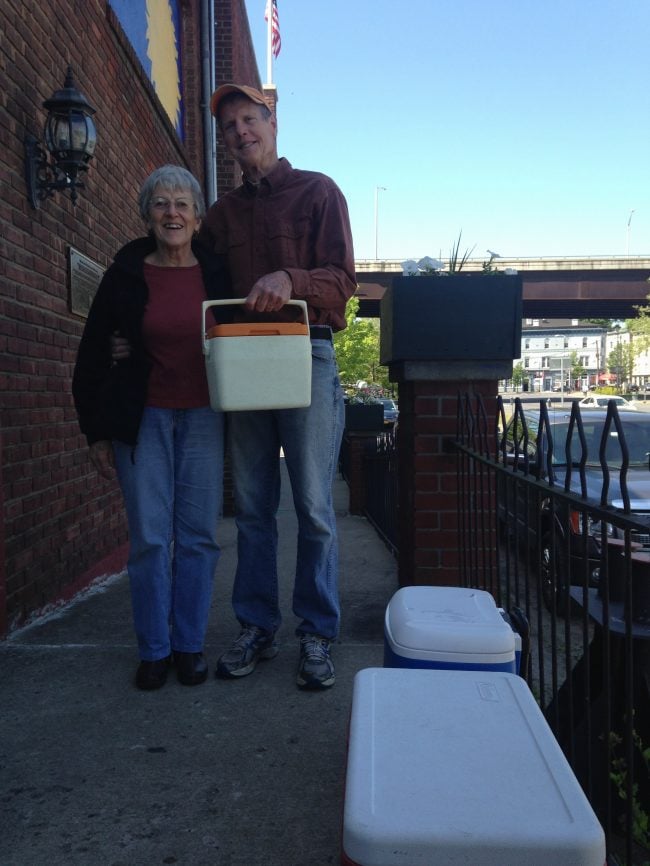Water science projects expand in breadth and depth

Time Warner Cable documents the first sampling of the Saw Kill Watershed Community on May 20, 2016. (Photo by Dan Shapley / Riverkeeper)
View more images on our Flickr site
The 2016 water sampling season is in full swing, with Riverkeeper and our partners set to take samples from more than 330 locations over 12 days in May, providing our largest ever snapshot of water quality in the Hudson River Watershed. As the season continues, the number of sites sampled per month will grow.
Since the pilot project kicked off in 2006, the program has been built on the work of Capt. John Lipscomb and our partnership with Dr. Greg O’Mullan of CUNY Queens, and Dr. Andrew Juhl and Carol Knudson of Columbia University’s Lamont-Doherty Earth Obeservatory. On May 19, John and Carol gathered the first samples of the season for our core Hudson River Estuary monitoring project. This year, that core project is growing with the addition of partnerships with Cornell University to gather data on pharmaceuticals, personal care products and pesticides; the U.S. Environmental Protection Agency to gather data on tracers of wastewater effluent and pharmaceuticals; and O’Mullan to gather data on microbial communities. We’ll also sample additional sites in the Harlem River.
Our community science partners are also kicking off the sampling season. On May 14, the Sparkill Creek and Pocantico River watershed alliances gathered samples and delivered them to the Center for the Urban River at Beczak (CURB), a Sarah Lawrence College facility where they will be analyzed this year. On May 19, CURB processed samples from community scientists who gathered them in the Saw Mill River. That same day, the New York City Water Trail Association, the River Project and an array of partners kicked off another season of sampling New York City water access points, and we kicked off our sampling season at our new Kingston lab at the Hudson River Port, in the Hudson River Maritime Museum, processing samples taken by community scientists in the Catskill and Esopus Creeks.

Nadia and Dick Kirgan drop off samples drawn from the Esopus Creek – the first samples delivered to Riverkeeper’s new Hudson River Port lab in Kingston. (Photo by Dan Shapley / Riverkeeper)
May 20, the Saw Kill Watershed Community gathered samples for processing at the new Bard Water Lab, and on May 21, the new Roe Jan Watershed Association will also deliver samples there. Also May 20, we’ll take in samples from the Rondout Creek and Wallkill River, where we will gather additional data this year in support of Hudson River Estuary Program-funded projects to track sources of fecal pollution and to measure algae and nutrients with the Wallkill River Watershed Alliance.

Time Warner Cable documents the first sampling of the Saw Kill Watershed Community on May 20, 2016. (Photo by Dan Shapley / Riverkeeper)
On May 23, John and Carol complete the estuary sampling in time to sample the Mohawk River watershed in collaboration with SUNY Cobleskill, which received funding from the Mohawk River Basin Program to expand sampling this season.
Later this season, our partners at Ossining High School will resume sampling Ossining’s Hudson River beach, and we plan to sample the East River to the Throgs Neck, for the first time, and the Upper Hudson to its headwaters. By the end of the season, we expect to have made some 7,600 measures of water quality from about 380 locations spanning roughly 800 river miles. It’s the most extensive project of its kind, to assess when and where water is fit for recreation — filling a data gap and creating a legion of advocates for the water in the process. It is impossible without many partners – three dozen and counting. Our heartfelt and ongoing thanks goes to them.
